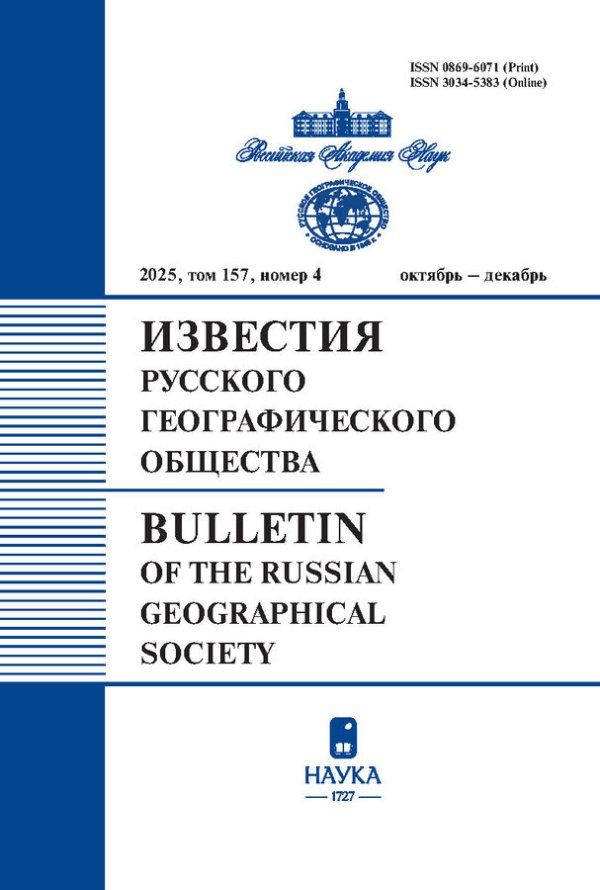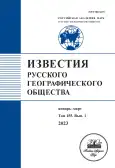Vol 155, No 1 (2023)
Articles
Geomorphometric Methods Application for Lake Ladoga Bottom Morphology Investigation
Abstract
Abstract
—In present research results of Lake Ladoga bottom morphology analysis are presented. Semi-automated instrumental classification of digital bathymetric model with application of geomorphometric parameters was executed to achieve the goal. Bathymetric position index and slope were used as classifiers. As a result, 8 types of surfaces were distinguished, which were mapped on the morphological scheme. Plains, slopes and linear top (ridges, heights) and bottom (hollows, depressions) were distinguished. Combinations of such elements allow to contour 3 zones which correlate to morphostructural areas: South-Ladoga, Central-Ladoga, North-Ladoga. Differences of these zones depend on both lake’s basin geological structure and exogenous factors of Late-Pleistocene-Holocene (glacial, glacial lacustrine processes). The suggested approach proves high efficiency for Lake Ladoga greatly variable morphology study.
 3-12
3-12


In-stream Mining in Alluvial River Channels: Response, Consequences and Perspectives
Abstract
Abstract
—On the basis of long-term field and analytical research, the response of the channels of different rivers to one of the types of mechanical impact on rivers – the in-stream mining – is considered. The nature and rates of the response of the river channels of free-flowing and regulated rivers to the in-stream mining, disturbance extent of the channel morphology and the rivers hydrological regime are revealed. The purpose of the work is to assess the possibilities of in-stream mining and allowable mine’s sizes which bases on the general principles of the theory of fluvial processes, and to minimize the negative effects of given mechanical disturbances on rivers and floodplains
 13-20
13-20


Geochemical Characteristics Infiltration Deposits Kungur Ice Cave (Preduralie)
Abstract
Abstract
—The results of spectral analyses of infiltration deposits of a large karst system in carbonate-sulfate deposits are presented. The movement of loose material from the surface through deformation zones within an array with a capacity of 80–90 m leads to accumulations of gravel-clay deposits in the lower part of grottoes and galleries. The localization of deposits is confined to certain forms of underground karst relief – organ pipes: vertical structures up to 20–25 m high, free or filled with debris. Regularities in the distribution of individual oxides and elements are revealed, their values are compared with residual deposits, as well as matrix rocks. Infiltration waters entering the karst massif in the pre-paleogenic stage determined the conditions for the formation of cryogenic minerals during the freezing of rocks. The cyclical nature of the material intake is compared with the periods of Late Pleistocene climatic events.
 21-29
21-29


Industrial Regional Space in the “Core–Periphery” System in Russia
Abstract
Abstract
—the center-periphery model is used to explain modern geographical processes and phenomena, but nobody systematically studies the position of Russian regions in the system of center-peripheral relations. The current study is aimed at eliminating this gap. The purpose of research is to test the methodology for identifying central and peripheral regions in the Russian industrial space and the main features of the industrial development of different types of regions. Statistical and mathematical-statistical research methods based on Rosstat data in 2005–2020. The sample included 83 subjects of the Federation (with the exception of the Republic of Crimea and Sevastopol), for which there are comparable data series. All regions are assigned to one of the types: core, sub-center, sub-periphery, periphery. The nuclear regions include highly industrial regions with a high base and competitive industries. The group of sub-center regions includes medium-sized industrial regions with high dynamics. The sub-periphery concentrated 40% of the Russian regions. Regions of this group were further divided into subtypes according to the dynamics of industrial development and specialization. The periphery was divided into 2 subtypes: 1) depressed regions with a high base shrinking in the post-soviet period; 2) underdeveloped regions with a low base. It is noted that shifts in the center-periphery system are inertial. Over the past 15 years, the concentration of industrial production in cores and sub-centers has increased, but the investment dynamics is higher in sub-centers. The role of old-industrial sub-peripheral regions is most strongly reduced. The role of the underdeveloped periphery in industrial employment of the population is increasing. The findings can be used to further adjust the regional industrial policy and develop a strategy for the spatial development of Russia.
 30-42
30-42


The Possibility of Using Modern Methods and Data to Study the Spatial Structure of the St.-Petersburg Agglomeration
Abstract
Abstract
—The article is devoted to the review and substantiation of modern research methods and data sources on the dynamics of spatial structure of the largest Russian urban agglomerations. The object of the study is modern methods and data sources, and the subject is the possibilities of their use. On the example of the second agglomeration in Russia – St.‑Petersburg urban agglomeration – it is shown that interdisciplinary synthesis within the framework of socio-economic geography, regional economics, urban studies, geoinformatics and cartography, land management, using a variety of data sources (data of cellular operators, tax statistics, housing construction, satellite data, retail chains, road network), as well as the use of modern GIS-complexes, allow us to assess this structure, its changes, as well as to analyze the spatial structure of the largest Russian urban agglomerations. The main objective of this study is to review and critically rethink the methods of studying the spatial structure of one of Russia’s largest urban agglomerations (St.-Petersburg) developing in the turbulent period between 2014 and 2022. An inventory of different methods and data sources was made, using the method of reasoning. Further, the advantages and disadvantages of each group of methods were identified. Through an in-depth bibliographic analysis, the limitations and possibilities of empirical content (availability of specific data sources) were identified. Based on the critical analysis of advantages and disadvantages, a final point estimate of applicability and usefulness of the considered methods for the St. Petersburg urban agglomeration is obtained. The author’s contribution lies in the adaptation of modern groups of methods for the study of the spatial structure of cities for the study of the considered agglomeration, taking into account the local specificity and assessment of applicability and usefulness of the considered methods for St. Petersburg urban agglomeration. It is assumed that the development of a modern methodology for studying the spatial structure of the St. Petersburg urban agglomeration based on the symbiosis of modern methods and data sources will make a certain contribution to the study of the largest Russian agglomerations.
 43-58
43-58


Scientific Support of Gully Rehabilitation in Protected Landscapes
Abstract
Abstract
—The experience of scientific support of work on the rehabilitation of the gully on the Cape Burkhan on the Olkhon Island (south of Eastern Siberia, Lake Baikal) is considered in this article. Cape Burkhan is a unique natural monument with a recognizable landscape and a high-status tourist attraction, which is exposed to a high recreational impact. The processes of linear erosion develop in this area most intensively due to the characteristics of the lithological and geological structure and morphological parameters. The anthropogenic factor has the greatest influence on the activation of dangerous geomorphological processes, including erosional ones. As a result of the study, the comprehensive analysis of the territory was carried out: initial conditions, causes, and factors of vegetation and soils degradation, activation of erosion processes. Various approaches to the technological and biological stages of gully rehabilitation were analyzed. Detailed recommendations have been developed to reduce the recreational impact on the relief and carry out restoration work. The proposed approaches to rehabilitation can be used on other gullies on Olkhon Island and the Priolkhonskoe plateau.
 59-72
59-72


On the Allocation of Regional Geological Monuments of the Main Devonian Field
Abstract
Abstract
—Using the example of two particularly valuable geological objects of the Main Devonian Field (Ilmen glint and the valley of the Velikaya River in the area of the Vybuty rapids), the features of the allocation and protection of geological monuments of regional significance are considered. Ilmen glint is a complex (stratigraphic, paleontological, ore-litho-petrological, hydrogeological) geological monument of regional significance. The authors substantiate the paleogeographic value of the object, which consists in the possibility of studying various ecological complexes of the macrofauna of the Middle Frasnian Sea, reflecting both regressive and transgressive stages of its development. Also, for the Ilmen glint are recommended two new criteria: a historical criterion (reflection of information about a geological object in the classical geological literature) and (for the first time) the introduction of a new historical and geographical criterion (the relationship of geological and geographical features with the history of settlement and development of the region). As a unique geological object, Ilmen glint has been studied by outstanding Russian and foreign researchers. The sections of the glint and the near-glint region are stratotypic for a number of sub-regional and local subdivisions of the Middle Frasnian of the Main Devonian Field. The features of the geological structure (close occurrence to the surface of carbonate rocks of the Upper Devonian), proximity to Novgorod and convenient communication with it by water influenced the fact that this area became one of the areas of ancient mining back in the days of Veliky Novgorod. Due to the location at the crossroads of important roads, the surroundings of glint often turned out to be the scene of important historical events, so in the village of Korostyn, located at the western tip of glint, the famous Korostyn Peace was concluded. The Vybuty Rapids tract is not a protected area, although it also has a clear scientific value from the paleogeographic (interesting complexes of ichnofossils are observed in the outcrop and extremely valuable in the reconstruction of paleogeographic conditions of the hardground facies) and historical and geographical points of view (a large ford was the strategic place in the Middle Ages for Pskov). The article considers the influence of natural and anthropogenic hazards on the condition of the described geological objects. In the described unique outcrops, there is an active manifestation of landslide processes and weathering processes. At the same time, the terrain features (the presence of local plicative and disjunctive structures that contribute to the formation of zones of increased fracturing) are aggravated by the active traffic load in the areas adjacent to the coastal cliffs.
 73-88
73-88










